The Figure of the Teacher-Prosumer for the Development of an Innovative, Sustainable, and Committed Education in Times of COVID-19
Abstract
1. Introduction
1.1. The Figure of the Teacher-Prosumer
1.2. The Educational Innovation Project “Teachers Versus COVID-19”
Coordinate curriculum learning and special education to fight against the “epidemics”, and strengthen the guidance of patriotism education. It focuses on the education of advanced deeds and epidemic prevention knowledge, life education, public safety education, and mental health education as important learning content. It guides students to correctly understand the relationship between humans, society, and nature, to respect the objective world, and to act in a scientific and rational way.[20]
1.3. Research Question and Aims
- SO1
- Test whether the figure of the teacher-prosumer contributes to improve the adaptation of face-to-face teaching to the virtual modality of the Didactics of Social Sciences in the Degree in Primary Education during lockdown.
- SO2
- Analyze the production of content on social networks by the students in the Degree in Primary Education, according to the objectives of sustainable development.
2. Materials and Methods
- Focus. During the focus phase, the purpose of the project was defined after the analysis of the educational needs and the identification of the problem. In this case, the problem arising from the lockdown decree due to the outbreak of the COVID-19 pandemic originated the sudden need to adapt teaching to the situation. Opportunities that could be addressed through the solution of the problem were also taken into account. Considering all this, the purpose of the project was established in adapting the subject to emergency remote learning and promoting the figure of teachers-prosumers for the teaching of social sciences through SDGs and COVID-19 issues. Given that the teaching team involved in this project had four class-groups assigned to them, a convenience sample was selected, consisting of N = 240 students (155 female students and 85 male students), aged 22 to 23 years old, who were taking the compulsory course Didactics of Social Sciences of the Degree in Primary Education at the University of Malaga during the second semester of the 2019/2020 academic year. These 240 students were organized into 37 working groups of between 5 to 8 members.
- Understand. During this phase, learners, contexts, and existing solutions were studied. As the beginning of this course coincided with the beginning of the period of lockdown, the teaching team did not know the students personally; so a forum was built in the virtual campus of the course where we could introduce ourselves and freely comment on how we were emotionally coping with the situation we were living in. Based on the testimonies, we set the profile of the students in three categories associated with the context of the pandemic: students not affected by COVID-19; students with relatives affected (even hospitalized) by COVID-19; and students with relatives in the front line. On the other hand, an open-ended questions survey was designed as a pre-test with the aim of getting to know the students’ previous ideas through an empirical data collection method, specifically, their opinion on the social problems of the COVID-19 pandemic, or their possible active role in improving the social problems derived from COVID-19. In addition, the revision of the literature led to a process of documentation on theories and models of teaching and learning that would help understand the problem through the analysis of other solutions applied to similar problems. Finally, the students carried out a critical literacy process through a group activity based on the creation of a list of content for the Primary Education Curriculum related to the problem of COVID-19 that could be addressed through social sciences at all levels and in all year groups in primary education.
- Define. In this phase, the research question and the learning goals were defined. It was decided that the research question generated by the problem studied is the following: Can the teacher-prosumer figure favor the initial training of teachers in Social Science Didactics from the perspective of the relevant social problems during the pandemic? The learning goals were based on the development of critical, historical, geographical, social-citizen, empathic, media, audio-visual, and digital competencies.
- Conceive. In the conceive phase, the designer teaching team proposed the solution to the problem established in the define phase. The plan designed to achieve the objectives consisted of suggesting that students designed educational videos aimed at Primary Education students and addressed relevant social problems from the didactics of Social Sciences according to the SDGs. In order to do this, the students prepared a written explanatory document about the educational video that included the organization and distribution of roles and tasks to be carried out, as well as a transcript of the audio-visual script.
- Test. In this phase, the teaching team evaluated the effectiveness of these scripts and the achievement of the learning goals, in order to test the effectiveness of the theory. This phase is iterative and has the purpose of testing the procedure in order to achieve the improvement of the resulting educational material in the next phase. Testing during the design process of teaching materials, without waiting for them to be finished, is an inherent characteristic of educational design-based research.
- Build. In this phase, the students as designers and teachers-prosumers created educational videos (3–5 min long) in different formats explaining the problem of COVID-19 through the teaching of social sciences.
- Test. The effectiveness of the solution to the educational problem is evaluated in this new phase of the Test. To do this, this phase was divided into two testing procedures: assessment and post-test. For the assessment procedure, the students carried out an open survey in order to test the achievement of the learning goals, the effectiveness of the educational videos and their assessment of the project. This open survey would be used to collect data and submit them to three evaluation procedures: individual self-evaluation, group co-evaluation, and evaluation of the teaching team. The questions for the open survey were the following (Table 1).
- It is suitable for the association of the contents of the legislative curriculum of Social Sciences of Primary Education with relevant social problems.
- It includes Sustainable Development Goals.
- It uses language adapted to the level of primary education.
- It adjusts to the duration established (3–5 min).
- It uses freely accessible graphic resources.
- It is based on scientific, reliable, and proven bibliographic sources.
- It includes header and credits in the videos where all the information related to the organization of tasks and roles of the group members is shown.
- It develops their creative ability.
- Present. In this phase, educational videos are disseminated on social media (through the project’s YouTube channel and Instagram account) with the aim of having this didactic material used in schools for face-to-face or virtual teaching. The designer students disseminated the videos in the schools where they had carried out their internships as teachers in training. They explained the value of educational videos to teach about the relevant social problems related to the pandemic from the social sciences perspective, taking into account the SDGs.
3. Results
3.1. Curriculum of Social Sciences and Relevant Social Problems
3.2. Sustainable Development Goals and Creation of Audiovisual Content
4. Discussion
“What I have liked the most is undoubtedly being able to create something that is useful for primary school students, to create a project that primary school students can understand, feel identified with, empathize, and relate knowledge based on what they are experiencing. That was the best gift that the course gave to me. The first day, when I learned what the course would be about and the great initiative that was going to be carried out, I literally ran, excited to tell it to my mother (a teacher). My opinion and my expectations about this project have not changed, I am very satisfied and happy with the result. I have learned to take advantage of obstacles. This pandemic seemed to be an obstacle and an immense problem to continue educating and teaching and it has turned out to be the opposite, an incredible opportunity for renewal and educational improvement, a challenge. I have no doubt that education, whatever happens, will always be the best resource to improve the world. I would like to thank you for your good work, dedication and involvement on the subject and education. Thank you for being such good teachers and for knowing how to see how we could contribute pertaining to the needs of primary school students and for unifying everything in such an initiative, thank you”.(Student Group D)
“Teaching is not transferring knowledge, but creating possibilities for your own production or construction”, said Paulo Freire. Yes, I definitely think it has been that way thanks to the incredible project that we have built together. With the motto of “Teachers Versus COVID-19” we have committed ourselves, despite the new and complicated situation we were facing, not to stop education, to squeeze it to the maximum in order to take advantage of the problems in which we found ourselves perceive them as a challenge, a starting point, a push forward and motivation to reinforce the education and learning of many primary school students in terms of content of the formal and hidden curriculum in the area of social sciences, relating emotions and the experiences that the students are living with other moments in history, other values, knowledge and content that were within the teaching planning in this area. Personally, I believe that it is the best way to learn something, to make sense of what is taught from what is lived.(Student_Group A)
5. Conclusions
Author Contributions
Funding
Institutional Review Board Statement
Informed Consent Statement
Data Availability Statement
Conflicts of Interest
References
- Triviño-Cabrera, L. Utopia, historical thought and multimodality for the media empowerment of the pre-service trainee history teachers. Int. J. Res. Hist. Didact. Hist. Educ. Hist. Cult. (JHEC) 2019, 40, 129–140. [Google Scholar]
- Triviño-Cabrera, L.; Bernárdez-Rodal, A.; Velázquez-Felipe, A. The @Filosoclips project: Teaching feminist philosophy through popular culture in Spain. Gend. Educ. 2020, 1–15. [Google Scholar] [CrossRef]
- Bruns, A. The Future is User-led: The Path Towards Widespread Produsage. Fibreculture J. 2008, 11, 68–77. [Google Scholar]
- Genz, S. My Job is Me. Fem. Media Stud. 2015, 15, 545–561. [Google Scholar] [CrossRef]
- Bunes, M.; Blesa, B.; González, A.; González, J.J.; Pintado, M.; Tornel, M. Valores asociados a las experiencias del cuerpo en las comunicaciones de los jóvenes. Prism. Soc. 2016, 15, 34–83. [Google Scholar]
- Merelo, J.; Tricas, J. La irresistible ascensión del WhatsApp. ReVisión 2012, 6, 3–4. [Google Scholar]
- Sabater Fernández, C. La vida privada en la sociedad digital. La exposición pública de los jóvenes en internet. Aposta 2014, 61, 1–32. [Google Scholar]
- Asociación para la Investigación en Medios de Comunicación. Cuestionario 22ª Encuesta AIMC a Usuarios de Internet, 2019. Navegantes en la Red. Available online: http://download.aimc.es/aimc/Rub9aYt/macro2019_cuest.pdf (accessed on 20 December 2020).
- Royal Society for Public Health. #Status Of Mind. Social Media and Young People’s Mental Health and Wellbeing. 2017. Available online: https://www.rsph.org.uk/static/uploaded/d125b27c-0b62-41c5-a2c0155a8887cd01.pdf (accessed on 20 December 2020).
- Hall, S. Notes on Deconstructing ‘The Popular’. In Popular Culture. A Reader; Guins, R., Cruz, O.Z., Eds.; Sage: Newbury Park, CA, USA, 1981; pp. 64–71. [Google Scholar]
- Storey, J. Teoría Cultural. Cultura Popular; Octaedro: Barcelona, Spain, 2012. [Google Scholar]
- Walker, T. Adventures in Metropolis: Popular Culture in Social Studies. In Social Studies. The New Generation. Researching in the Postmodern; Segall, A., Heilman, E., Cherryholmes, C.H., Eds.; Peter Lang: Bern, Switzerland, 2006. [Google Scholar]
- Freire, P.; Macedo, D. Alfabetización, Lectura de la Palabra y Lectura de la Realidad; Paidós: Barcelona, Spain, 1989. [Google Scholar]
- Hess, D. Controversies about Controversial Issues in Democratic Education; Routledge: New York, NY, USA, 2009. [Google Scholar]
- Legardez, A.; Simonneaux, L. (Eds.) L’école à L’épreuve de L’actualité; ESF: Issy-les-Moulineaux, France, 2006. [Google Scholar]
- Tutiaux-Guillon, N. Les qüestions socialment vives, un repte per a la historia i la geografía escolars. In Les Qüestions Socialment Vives i l´Enseyament de Les Ciènces Socials; Pagès, J., Santisteban, A., Eds.; Universitat Autònoma de Barcelona: Bellaterra, Spain, 2011. [Google Scholar]
- Yves, A.; Barthes, A. De la question socialement vive à l’objet d’enseignement: Comment légitimer des savoirs incertains? Les Doss. Des Sci. L’éducation 2013, 29, 33–44. [Google Scholar] [CrossRef]
- Benejam, P.; Pagès, J. Enseñar y Aprender Ciencias Sociales, Geografía e Historia en la Educación Secundaria; ICE/Horsori: Barcelona, Spain, 1997. [Google Scholar]
- Pagès, J. La formación del pensamiento social. In Enseñar y Aprender Ciencias Sociales, Geografía e Historia en la Educación Secundaria; Benejam, P., Pagès, J., Eds.; ICE/Horsori: Barcelona, Spain, 1997; pp. 152–164. [Google Scholar]
- Zhou, L.; Li, F.; Wu, S.; Zhou, M. ’School’s Out, But Class’ On’, the Largest Online Education in the World Today: Taking China’s Practical Exploration During The COVID-19 Epidemic Prevention and Control as an Example. Best Evid. Chin. Edu. 2020, 4. [Google Scholar] [CrossRef]
- General Assembly of the United Nations. Transforming Our World: The 2030 Agenda for Sustainable Development. 2015. Available online: https://www.un.org/ga/search/view_doc.asp?symbol=A/RES/70/1&Lang=E (accessed on 20 December 2020).
- Giroux, H.; Rivera-Vargas, P.; Passeron, E.; Pandémica, P. Reproducción Funcional o Educación Antihegemónica. Rev. Int. Educ. Para Justicia Soc. 2020, 9. Available online: https://revistas.uam.es/riejs/article/view/12199 (accessed on 20 December 2020).
- Huang, R.H.; Liu, D.J.; Tlili, A.; Yang, J.F.; Wang, H.H. Handbook on Facilitating Flexible Learning during Educational Disruption: The Chinese Experience in Maintaining Undisrupted Learning in COVID-19 Outbreak; Smart Learning Institute of Beijing Normal University: Beijing, China, 2020. [Google Scholar]
- Reimers, F.; Scleicher, A. A Framework to Guide an Education Response to the COVID-19 Pandemic of 2020; OECD: Paris, France, 2020; Available online: https://globaled.gse.harvard.edu/files/geii/files/framework_guide_v1_002.pdf (accessed on 20 December 2020).
- Save the Children (2020). COVID-19: Cerrar la Brecha. Impacto Educativo y Propuestas de Equidad Para la Desescalada. Save the Children. Available online: https://www.savethechildren.es/sites/default/files/2020-05/COVID19Cerrarlabrecha.pdf (accessed on 20 December 2020).
- Trujillo-Sáez, F.; Fernández-Navas, M.; Montes-Rodríguez, M.; Segura-Robles, A.; Alaminos-Romero, F.J.; Postigo-Fuentes, A.Y. Panorama de la Educación en España Tras la Pandemia de COVID-19: La Opinión de la Comunidad Educativa; FAD: Madrid, España, 2020. [Google Scholar] [CrossRef]
- Trujillo-Sáez, F. (Ed.) Aprender y Enseñar en Tiempos de Confinamiento; Los Libros de la Catarata: Madrid, Spain, 2020. [Google Scholar]
- UNESCO. Education: From Disruption to Recovery. 2020. Available online: https://en.unesco.org/covid19/educationresponse (accessed on 20 December 2020).
- UNICEF. Framework for Reopening Schools. 2020. Available online: https://www.unicef.org/media/71366/file/Framework-for-reopening-schools-2020.pdf (accessed on 20 December 2020).
- Fonseca, J. Aprendizaje Servicio como método de enseñanza para la formación ciudadana y profesional responsable. Una propuesta de Responsabilidad Social Universitaria en la UNICACH. DEDiCA Rev. Educ. Humanid. (Dreh) 2020. [Google Scholar] [CrossRef]
- Anderson, T. Design-based research and its application to a call center innovation in distance education. Can. J. Learn. Technol. 2005, 31, 69–84. Available online: http://www.jofde.ca/index.php/jde/article/view/18/552 (accessed on 20 December 2020). [CrossRef]
- Easterday, M.W.; Lewis, D.G.R.; Gerber, E.M. The logic of design research. Learn. Res. Pract. 2018, 4, 131–160. [Google Scholar] [CrossRef]
- Brown, A.L. Design experiments: Theoretical and methodological challenges in creating complex interventions in classroom settings. J. Learn. Sci. 1992, 2, 141–178. [Google Scholar] [CrossRef]
- Collins, A. Toward a design science of education. In New Directions in Educational Technology; Scanlon, E., O’Shea, T., Eds.; Springer: Berlin/Heidelberg, Germany, 1992; pp. 15–22. [Google Scholar]
- Reeves, T.C.; Herrington, J.; Oliver, R. Authentic Activities and Online Learning; ECU Publications: Greenville, NC, USA, 2002. [Google Scholar]
- Barab, S.; Squire, K. Design-Based Research: Putting a stake in the ground. J. Learn. Sci. 2004, 13, 1–14. [Google Scholar] [CrossRef]
- Wang, F.; Hannafin, M.J. Design-based research and technology-enhanced learning environments. Educ. Technol. Res. Dev. 2005, 53, 5–23. [Google Scholar] [CrossRef]
- Cruz, I.M.; Acebal, M.C.; Cebrián, D.; Blanco, A. El juego de rol como estrategia didáctica para el desarrollo de la conciencia ambiental. Una Investigación Basada en el Diseño. Rev. Educ. Ambient. Sostenibilidad 2020, 2. [Google Scholar] [CrossRef]
- DBRC (The Design Based Research Collective). Design-based research: An emerging paradigm for educational inquiry. Educ. Res. 2003, 32, 5–8. [Google Scholar] [CrossRef]
- Cobb, P.; Confrey, J.; diSessa, A.; Lehrer, R.; Schauble, L. Design experiments in educational research. Educ. Res. 2003, 32, 9–13. [Google Scholar] [CrossRef]
- Van den Akker, J. Principles and methods of development research. In Design Methodology and Developmental Research in Education and Training; Van den Akker, J., Nieveen, N., Branch, R.M., Gustafson, K.L., Plomp, T., Eds.; Kluwer Academic Publishers: Amsterdam, The Netherlands, 1999; pp. 1–14. [Google Scholar]
- Glaser, B.; Strauss, A. The Discovery of Grounded Theory; Aldine Press: Venice, Italy, 1963. [Google Scholar]
- Prats, J.; Santacana, J. Veinte invariables para la enseñanza de la historia. In Ciencias Sociales, Ciudadanía y Sociedad Digital: Reflexiones Desde la Educación; Prats, J., Ed.; Trea: Alexandria, VA, USA, 2020; pp. 13–26. [Google Scholar]
- Rüsen, J. Historical consciousness: Narrative structure, moral function and ontogenetic development. In Theorizing Historical Consciousness; Seixas, P., Ed.; University of Toronto Press: Toronto, ON, Canada, 2004; pp. 63–85. [Google Scholar]
- Docentes Vs. Covid19. DocentesVsCOVID-19 [Channel]. Available online: https://www.youtube.com/channel/UCI1NtiZ4enltt53pPMA885g (accessed on 2 April 2020).
- Sadio-Ramos, F.J.; Ortiz-Molina, M.A.; Villodre, M.M.B. La formación del profesorado de Música para potenciar la creatividad desde la utilización de las TIC: Una experiencia biográfica. Rev. Electrónica Interuniv. Form. Profr. 2020, 23, 155–166. [Google Scholar] [CrossRef]
- Artacho, E.; Martínez, T.; Martín, J.O.; Marín, J.M.; García, G. Teacher Training in Lifelong Learning-the Importance of Digital Competence in the Encouragement of Teaching Innovation. Sustainability 2020, 12, 2852. [Google Scholar] [CrossRef]
- Magaña, E.C.; Rivas, E.S.; Palmero, J.R.; Rodríguez, J.S. (Eds.) La Tecnología Como eje Del Cambio Metodológico; UMA Editorial: Málaga, España, 2020. [Google Scholar]
- Hadar, L.L.; Ergas, O.; Alpert, B.; Ariav, T. Rethinking teacher education in a VUCA world: Student teachers’ social-emotional competencies during the Covid-19 crisis. Eur. J. Teach. Educ. 2020. [Google Scholar] [CrossRef]
- Gómez-Carrasco, C.; Miralles-Martínez, P. Pensar históricamente o memorizar el pasado? La evaluación de los contenidos históricos en la educación obligatoria en España. Rev. Estud. Soc. 2015, 52, 52–68. [Google Scholar] [CrossRef]
- Giménez, J.E. La formación del profesorado para enseñar la participación en el Grado de Maestro y en el Máster en Profesorado de Secundario. In Educar Para la Participación Ciudadana en la Enseñanza de las Ciencias Sociales; de-Alba-Fernández, N., García-Pérez, F., Fernández, A.S., Eds.; Universidad de Huelva: Huelva, Spain, 2012; pp. 211–220. [Google Scholar]
- Giroux, H.; McLaren, P. Sociedad, Cultura y Educación; Miño y Dávila Editores: Tacuarí, Buenos Aires, 1998. [Google Scholar]
- Docentes Vs. Covid19. DocentesVsCOVID-19 [Videol]. Available online: https://www.youtube.com/watch?v=6C__okU9tgA&t=29s (accessed on 2 April 2020).
- Europa Press Unos 300 Estudiantes de la Universidad de Málaga Explican la Realidad de la Pandemia a Menores con Vídeos Educativos. Europa Press. Available online: https://www.europapress.es/andalucia/malaga-00356/noticia-300-estudiantes-universidad-malaga-explican-realidad-pandemia-menores-videos-educativos-20200503110948.html (accessed on 3 May 2020).
- La Vanguardia. Coronavirus.-Unos 300 Estudiantes de la UMA Explican la Realidad de la Pandemia con Vídeos Educativos. La Vanguardia. Available online: https://www.lavanguardia.com/local/sevilla/20200503/48935727901/coronavirus--unos-300-estudiantes-de-la-uma-explican-la-realidad-de-la-pandemia-con-videos-educativos.html (accessed on 3 May 2020).
- Sala de Prensa de la Universidad de Málaga. 300 estudiantes del Grado en Educación Primaria crean vídeos sobre el COVID-19 para alumnado de entre 6 y 12 años. Universidad de Málaga. Available online: https://www.uma.es/sala-de-prensa/noticias/300-estudiantes-del-grado-en-educacion-primaria-crean-videos-sobre-el-covid-19-para-alumnado-de-entre-6-y-12-anos/ (accessed on 20 April 2020).
- García, S.; Aznar-Díaz, I.; Cáceres-Reche, M.P.; Torres, J.M.; Romero-Rodríguez, J.-M. Systematic Review of Good Teaching Practices with ICT in Spanish Higher Education Trends and Challenges for Sustainability. Sustainability 2019, 11, 7150. [Google Scholar] [CrossRef]
- Prensky, M. Digital Natives, Digital Immigrants. In On the Horizon; MCB Univeristy Press: Bingley, UK, 2001. [Google Scholar]
- Kress, G.; Van Leeuwen, T. Multimodal Discourse. The Modes and Media of Contemporary Communication; Arnold: London, UK, 2001. [Google Scholar]
- Kress, G. Multimodality: A Social Semiotic Approach to Contemporary Communication; Routledge: Abingdon, UK, 2010. [Google Scholar]
- González-García, J. Alfabetización multimodal: Usos y posibilidades. Campo Abierto 2013, 32, 91–113. [Google Scholar]
- Lacambra, A.M.M.; Ansorena, A.A. Empleo de la fotografía para desarrollar la alfabetización multimodal. propuesta de análisis. Didácticas Específicas 2017, 80–95. Available online: https://revistas.uam.es/didacticasespecificas/article/view/6756 (accessed on 20 December 2020).
- Lim, F.V. Developing a systemic functional approach to teach multimodal literacy. Funct. Linguist 2018, 5, 13. [Google Scholar] [CrossRef]
- Robinson, K. Finding Your Element: How to Discover Your Talents and Passions; Penguin Press: London, UK, 2014. [Google Scholar]
- Ho, L.C.; Barton, C. Critical harmony: A goal for deliberative civic education. J. Moral Educ. 2020. [Google Scholar] [CrossRef]
- Moreno-Fernández, O. Educación y ciudadanía planetaria. Concepciones del alumnado participante en programas educativos andaluces. Pedagog. Soc. Rev. Interuniv. 2015, 26, 229–261. [Google Scholar] [CrossRef]
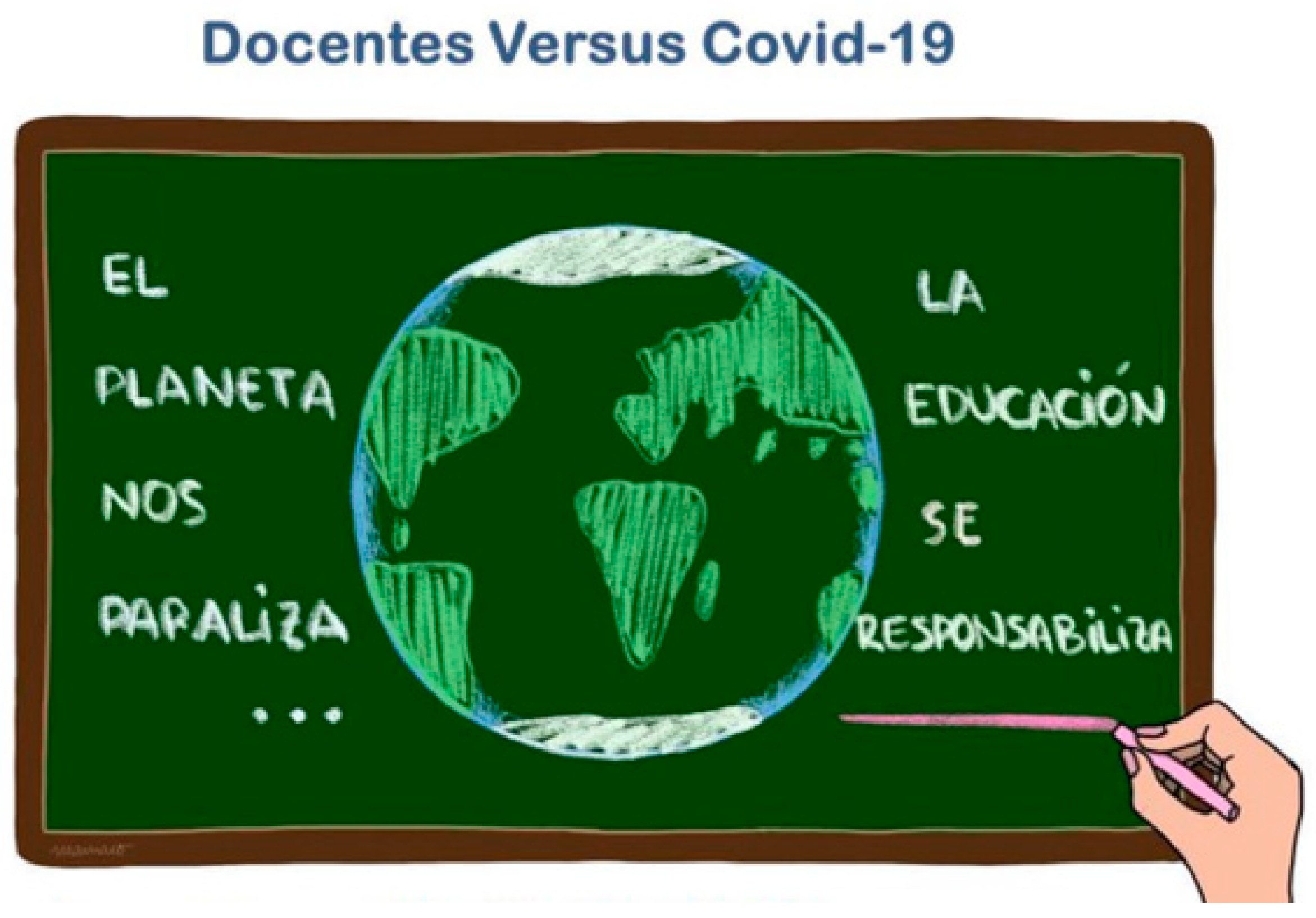
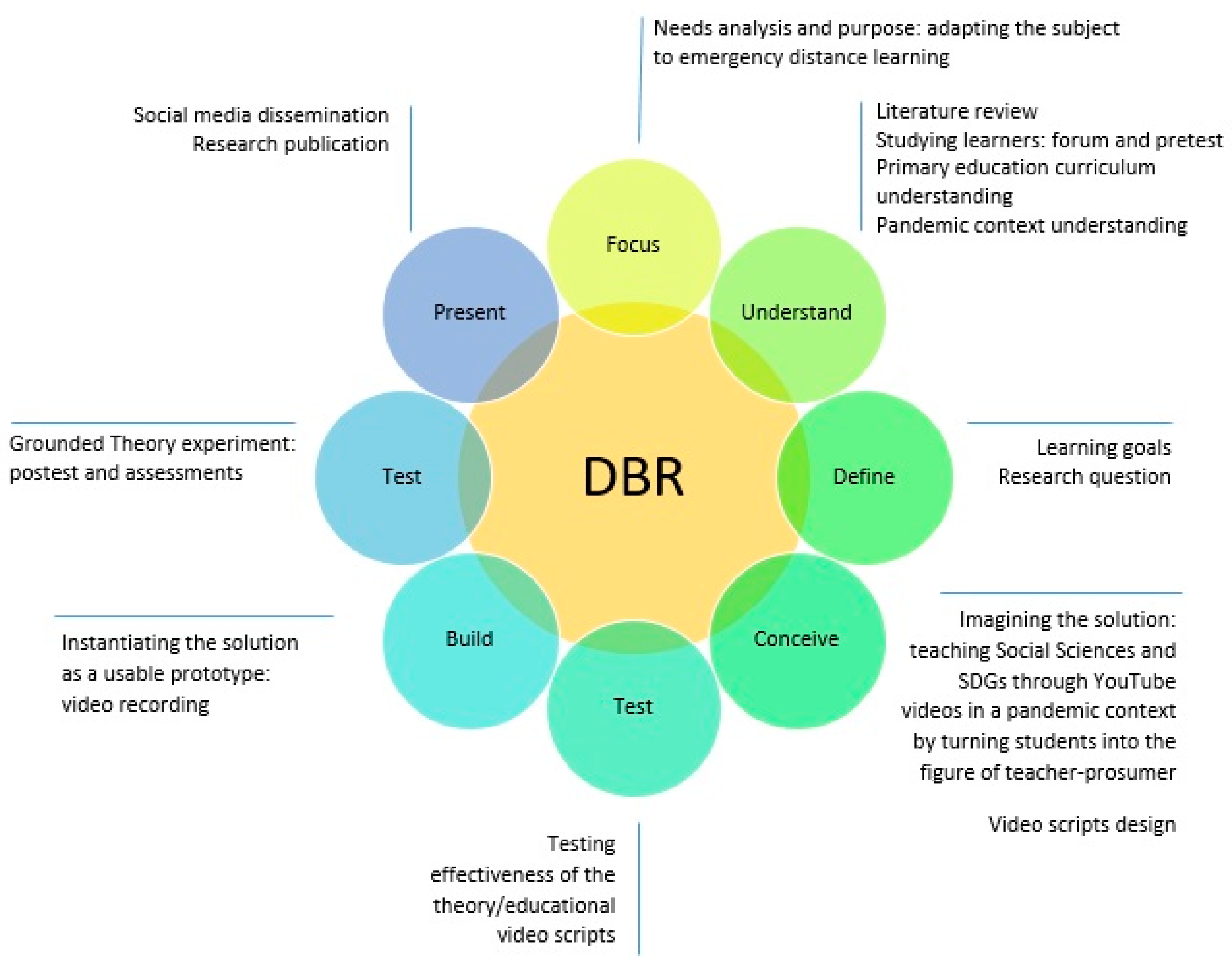
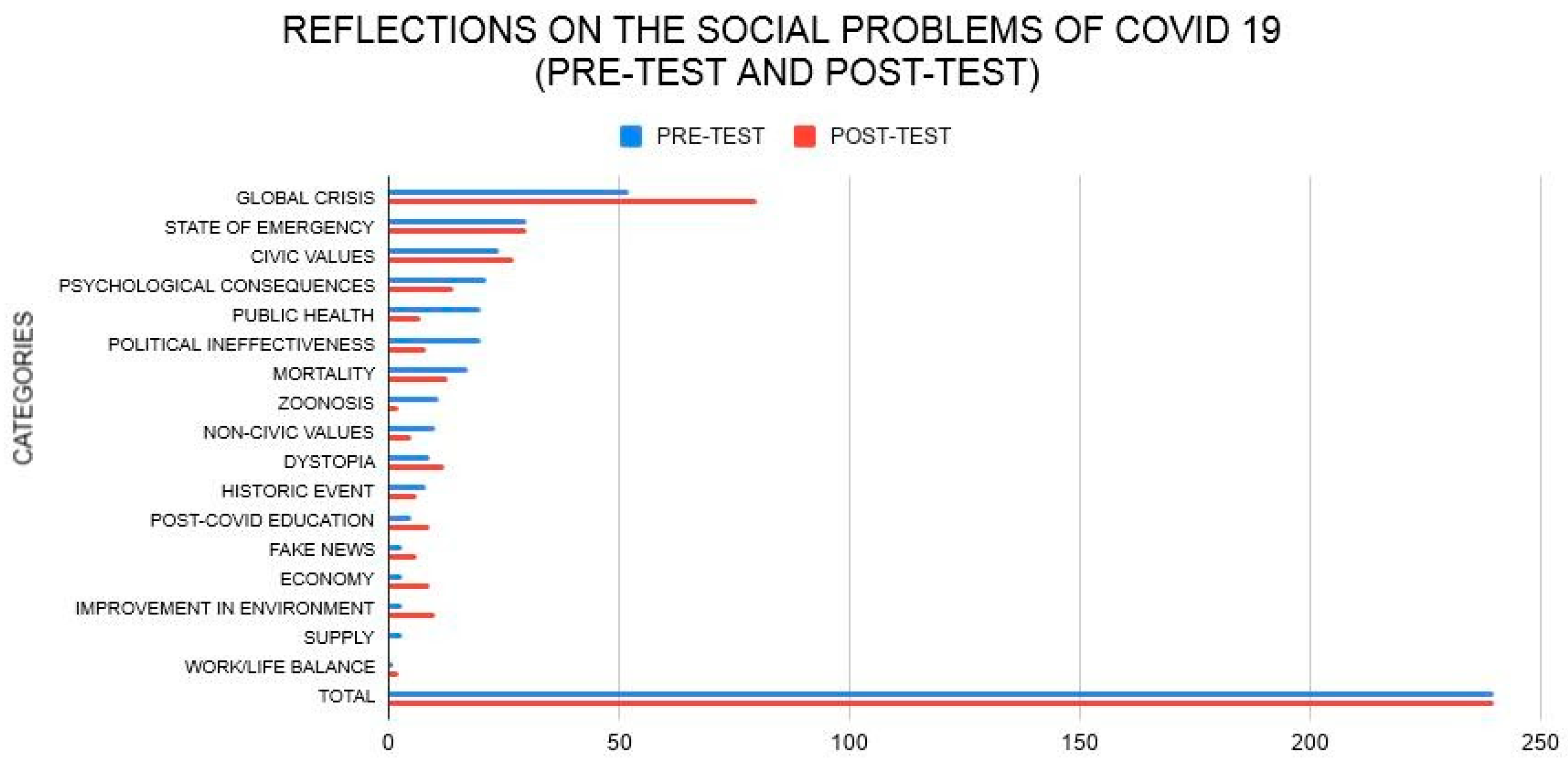
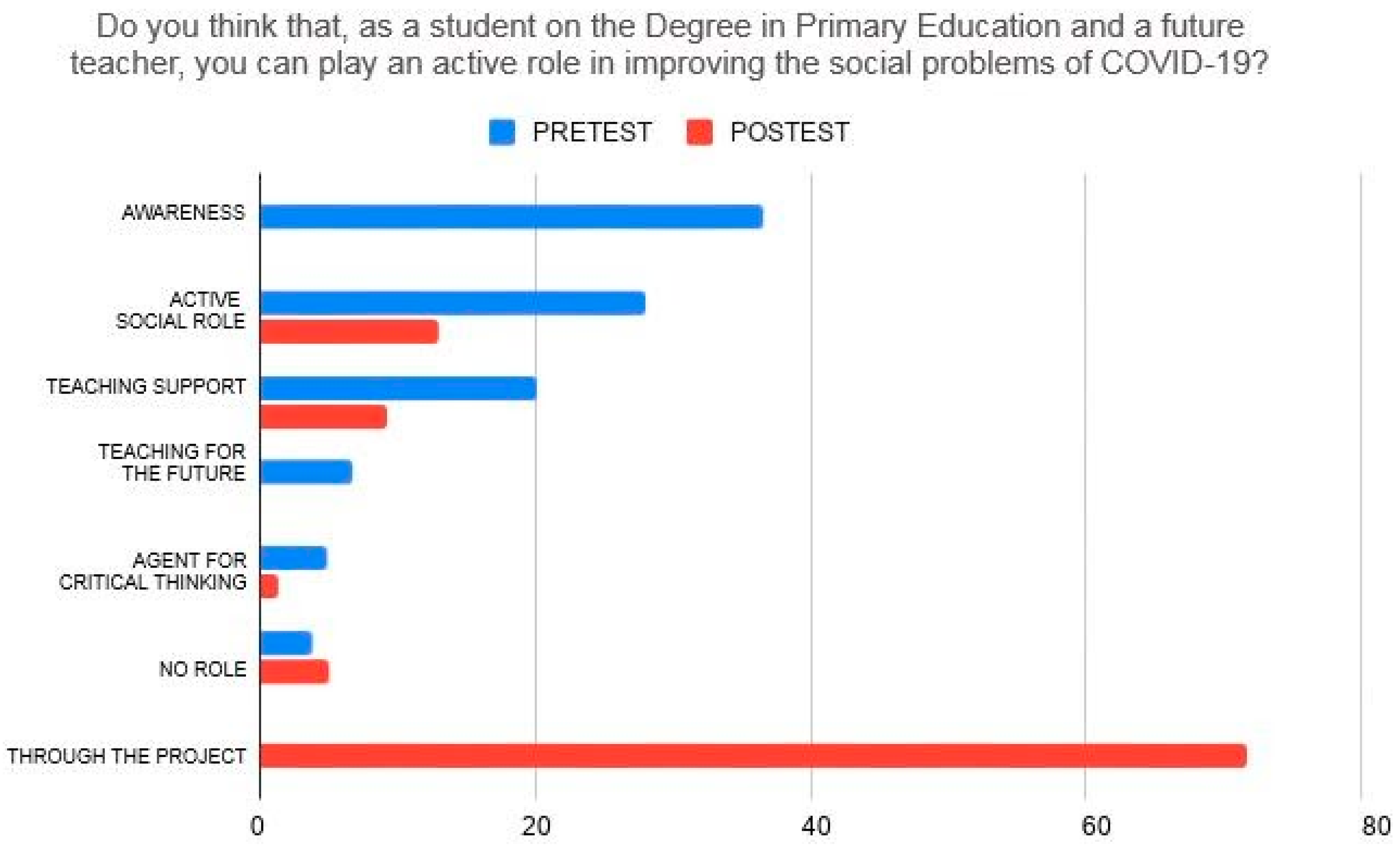
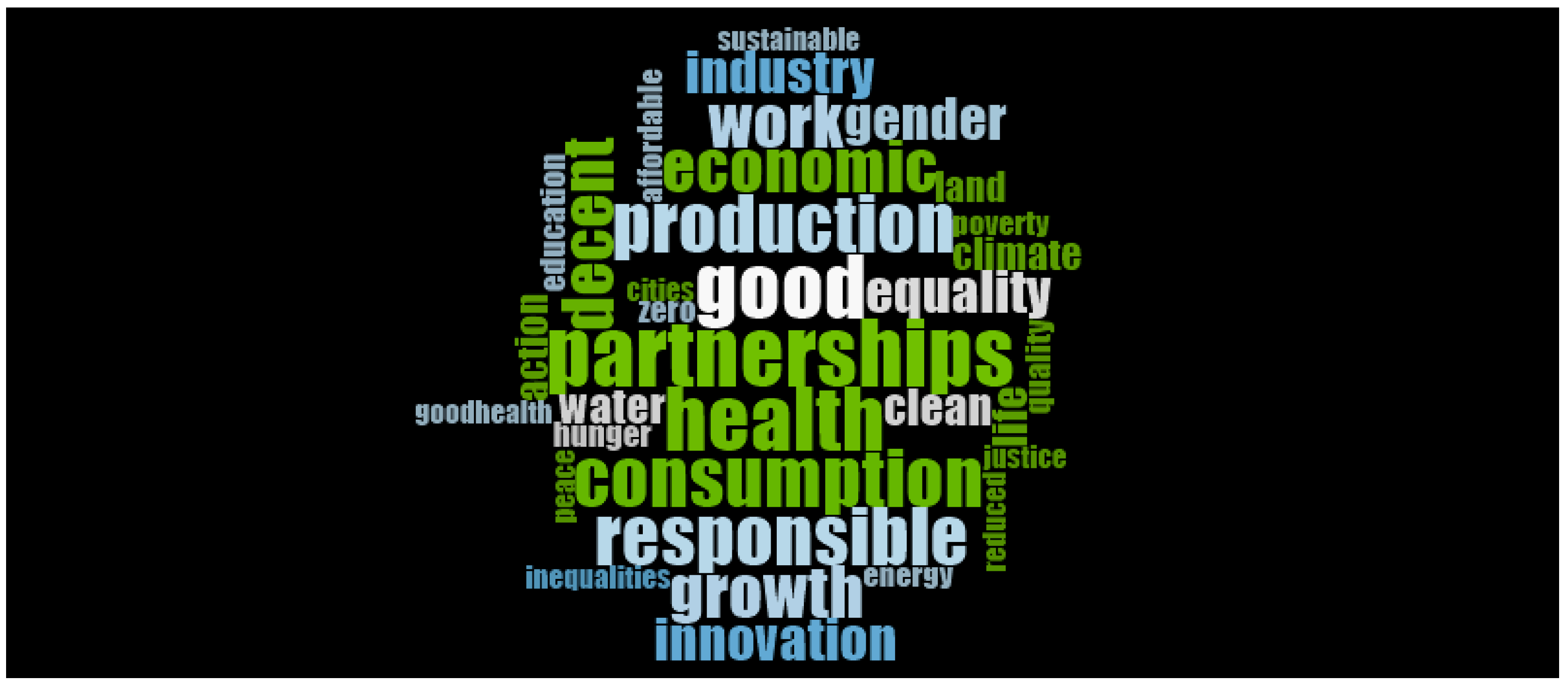
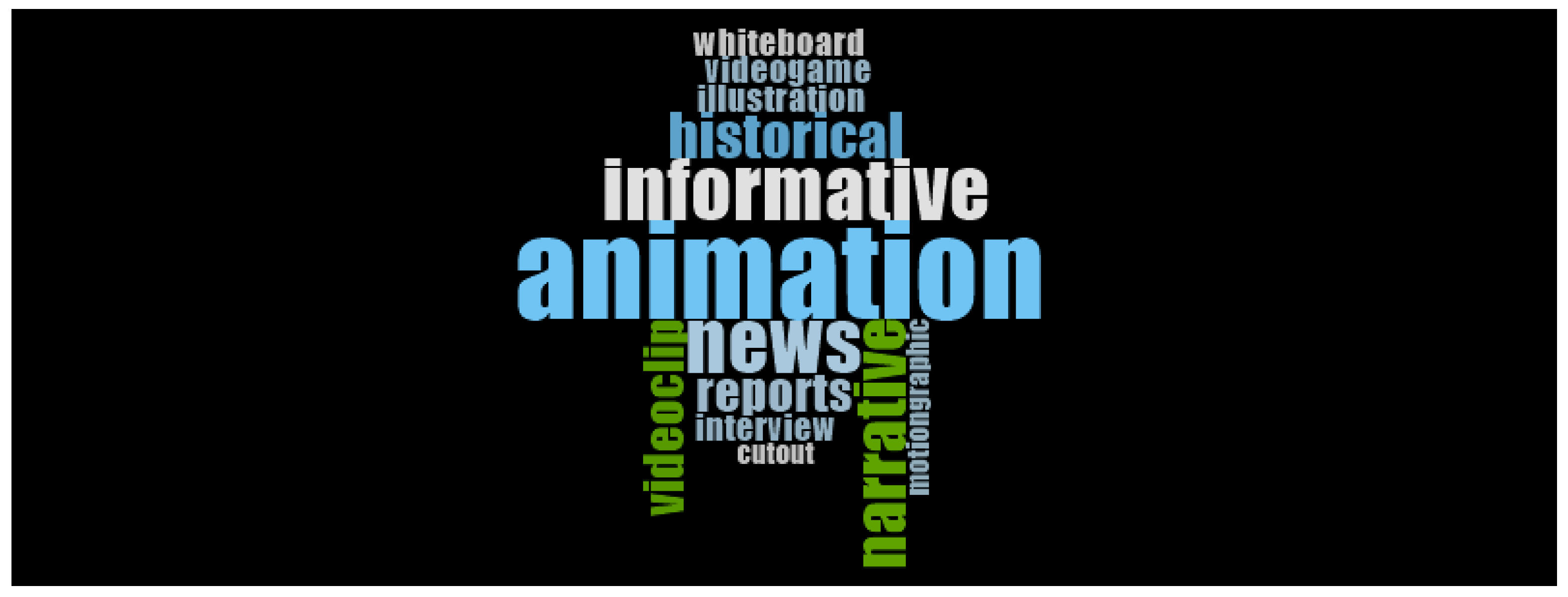
| Self-Evaluation |
|---|
|
| Co-Evaluation |
|
| Evaluation of the Teaching Team |
|
| Students | Pre-Test | Post-Test |
|---|---|---|
| Why Teach Social Sciences? | Why Teach Social Sciences? | |
| Student_Group A | It is necessary because we live in society and we must know how to perform in it and ensure that students learn how to perform in it. | By teaching social sciences, we help students to understand the social reality of the present and the past, favoring a critical sense when questioning historical facts. It is important to teach social sciences in order to transform reality and analyze relevant social problems, transmitting to students the values of the democratic society in which we find ourselves. |
| Student_Group B | So that the students question themselves and know where social sciences it comes from, and the reason for things. | Teaching social sciences involves making students think about what happened throughout different times, as well as making them empathize with it and everything learned can be carried out in their daily lives. They must learn the contents from the perspective of reality, giving it a meaning and being able to reflect on the situation as if they were the ones living it. |
| Student_Group C | To be able to understand the behaviors of the hu-man being and the different interactions carried out in the society which they live in. | I think that teaching social sciences is essential for the development of the human being. This subject or area, in addition to promoting many of the basic skills that students must acquire throughout their educational stage, encourages critical and reflective thinking; making the students understand what is happening around them and knowing how to act in the best possible way. Finally, we cannot forget that students not only learn and evolve pertaining to what the current situation is all about, but also understand that things or situations are like this for a reason, that is, a cause-consequence relationship. |
| Student_Group D | To understand the world around us and the relationships we establish with it. | As we have seen with the project carried out, this subject is very important so that students have access to the events that occur and that take place in the world in which they live, in order to understand what is happening and avoid feelings such as fear of the unknown. |
Publisher’s Note: MDPI stays neutral with regard to jurisdictional claims in published maps and institutional affiliations. |
© 2021 by the authors. Licensee MDPI, Basel, Switzerland. This article is an open access article distributed under the terms and conditions of the Creative Commons Attribution (CC BY) license (http://creativecommons.org/licenses/by/4.0/).
Share and Cite
Triviño-Cabrera, L.; Chaves-Guerrero, E.I.; Alejo-Lozano, L. The Figure of the Teacher-Prosumer for the Development of an Innovative, Sustainable, and Committed Education in Times of COVID-19. Sustainability 2021, 13, 1128. https://doi.org/10.3390/su13031128
Triviño-Cabrera L, Chaves-Guerrero EI, Alejo-Lozano L. The Figure of the Teacher-Prosumer for the Development of an Innovative, Sustainable, and Committed Education in Times of COVID-19. Sustainability. 2021; 13(3):1128. https://doi.org/10.3390/su13031128
Chicago/Turabian StyleTriviño-Cabrera, Laura, Elisa Isabel Chaves-Guerrero, and Laura Alejo-Lozano. 2021. "The Figure of the Teacher-Prosumer for the Development of an Innovative, Sustainable, and Committed Education in Times of COVID-19" Sustainability 13, no. 3: 1128. https://doi.org/10.3390/su13031128
APA StyleTriviño-Cabrera, L., Chaves-Guerrero, E. I., & Alejo-Lozano, L. (2021). The Figure of the Teacher-Prosumer for the Development of an Innovative, Sustainable, and Committed Education in Times of COVID-19. Sustainability, 13(3), 1128. https://doi.org/10.3390/su13031128







